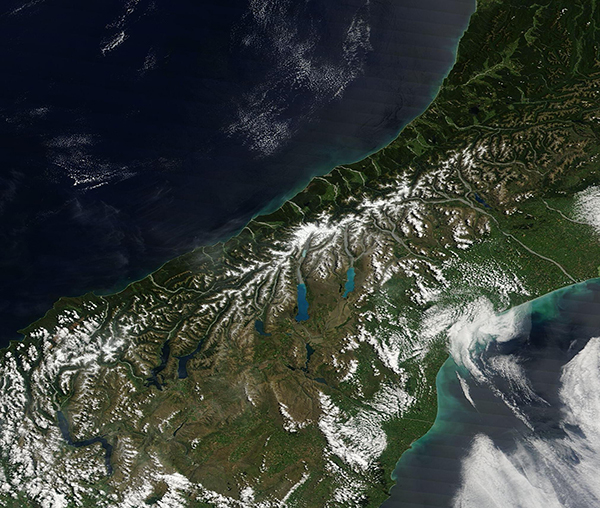Images
January 3, 2023 - Southern Alps, South Island, New Zealand
Tweet
On December 26, 2022, the Moderate Resolution Imaging Spectroradiometer (MODIS) on board NASA’s Terra satellite acquired a true-color image of an early summer day in New Zealand.
Stretching hundreds of miles across New Zealand’s South Island, the Southern Alps form a spine of white that contrasts with the surrounding green and brown landscape. The highest peak in the mountain range, known as Aoraki Mount Cook, rises approximately 3,750 meters (12,300 feet) above sea level and appears as the brightest and largest area of snow atop the Southern Alps.
The elevation of the range creates a rain-shadow effect east of the mountain range. The mountains and their foothills on the west side, which is also nearest the coastline, experience frequent rain and snowfall year-round, while the downwind (east side) of these peaks have a more arid climate and many cloud-free days. This difference is apparent in this image, with the coastal area (actually the west side of the island) covered with green vegetation while the opposite side is colored in tans.
South Island is also marked by the Alpine Fault, the major surface expression of the boundary between the Indo-Australian and the Pacific tectonic plates. The central section of the fault runs the length of South Island. As the plates progressively converge, the Southern Alps should continue to rise skyward over time.
Image Facts
Satellite:
Terra
Date Acquired: 12/26/2022
Resolutions:
1km (247.1 KB), 500m (662.7 KB), 250m (492.6 KB)
Bands Used: 1,4,3
Image Credit:
MODIS Land Rapid Response Team, NASA GSFC
Tweet
On December 26, 2022, the Moderate Resolution Imaging Spectroradiometer (MODIS) on board NASA’s Terra satellite acquired a true-color image of an early summer day in New Zealand.
Stretching hundreds of miles across New Zealand’s South Island, the Southern Alps form a spine of white that contrasts with the surrounding green and brown landscape. The highest peak in the mountain range, known as Aoraki Mount Cook, rises approximately 3,750 meters (12,300 feet) above sea level and appears as the brightest and largest area of snow atop the Southern Alps.
The elevation of the range creates a rain-shadow effect east of the mountain range. The mountains and their foothills on the west side, which is also nearest the coastline, experience frequent rain and snowfall year-round, while the downwind (east side) of these peaks have a more arid climate and many cloud-free days. This difference is apparent in this image, with the coastal area (actually the west side of the island) covered with green vegetation while the opposite side is colored in tans.
South Island is also marked by the Alpine Fault, the major surface expression of the boundary between the Indo-Australian and the Pacific tectonic plates. The central section of the fault runs the length of South Island. As the plates progressively converge, the Southern Alps should continue to rise skyward over time.
Image Facts
Satellite:
Terra
Date Acquired: 12/26/2022
Resolutions:
1km (247.1 KB), 500m (662.7 KB), 250m (492.6 KB)
Bands Used: 1,4,3
Image Credit:
MODIS Land Rapid Response Team, NASA GSFC




